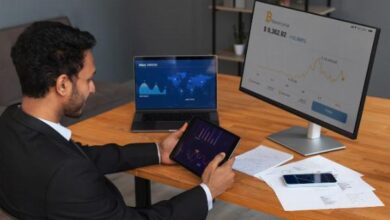How Does Bitcoin Mining Work ?
What Is Bitcoin Mining ?
Bitcoin mining is the process by which new bitcoins are entered into circulation. It is also the way the network confirms new transactions and is a critical component of the blockchain ledger’s maintenance and development. “Mining” is performed using sophisticated hardware that solves an extremely complex computational math problem. The first computer to find the solution to the problem receives the next block of bitcoins and the process begins again.
Cryptocurrency mining is painstaking, costly, and only sporadically rewarding. Nonetheless, mining has a magnetic appeal for many investors who are interested in cryptocurrency because of the fact that miners receive rewards for their work with crypto tokens. This may be because entrepreneurial types see mining as pennies from heaven, like California gold prospectors in 1849. And if you are technologically inclined, why not do it?
The bitcoin reward that miners receive is an incentive that motivates people to assist in the primary purpose of mining: to legitimize and monitor Bitcoin transactions, ensuring their validity. Because many users all over the world share these responsibilities, Bitcoin is a “decentralized” cryptocurrency, or one that does not rely on any central authority like a central bank or government to oversee its regulation.
Why Bitcoin Needs Miners :
Blockchain “mining” is a metaphor for the computational work that nodes in the network undertake in hopes of earning new tokens. In reality, miners are essentially getting paid for their work as auditors. They are doing the work of verifying the legitimacy of Bitcoin transactions. This convention is meant to keep Bitcoin users honest and was conceived by Bitcoin’s founder, Satoshi Nakamoto.1 By verifying transactions, miners are helping to prevent the “double-spending problem.”
Double spending is a scenario in which a Bitcoin owner illicitly spends the same bitcoin twice. With physical currency, this isn’t an issue: When you hand someone a $20 bill to buy a bottle of vodka, you no longer have it, so there’s no danger you could use that same $20 bill to buy lotto tickets next door. Though counterfeit cash is possible, it is not exactly the same as literally spending the same dollar twice. With digital currency, however, as the Investopedia dictionary explains, “there is a risk that the holder could make a copy of the digital token and send it to a merchant or another party while retaining the original.”
How Much a Miner Earns :
The rewards for Bitcoin mining are reduced by half roughly every four years. When bitcoin was first mined in 2009, mining one block would earn you 50 BTC. In 2012, this was halved to 25 BTC. By 2016, this was halved again to 12.5 BTC. On May 11, 2020, the reward halved again to 6.25 BTC.
As of March 2022, the price of Bitcoin was around $39,000 per bitcoin, which means you’d have earned $243,750 (6.25 x 39,000) for completing a block. Not a bad incentive to solve that complex hash problem detailed above, it might seem.
To keep track of precisely when these halvings will occur, you can consult the Bitcoin Clock, which updates this information in real time. Interestingly, the market price of Bitcoin has, throughout its history, tended to correspond closely to the reduction of new coins entered into circulation. This lowering inflation rate increased scarcity and, historically, the price has risen with it.


